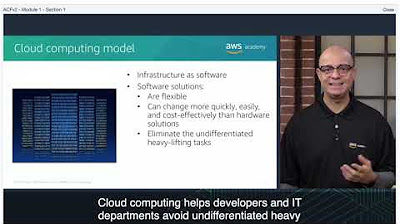IaaS and PaaS
Summary
TLDRThe video script discusses the evolution of cloud computing, highlighting the shift from traditional data centers to virtualized ones offering Infrastructure as a Service (IaaS) and Platform as a Service (PaaS). IaaS provides on-demand infrastructure like compute, storage, and network capabilities, with Google Compute Engine as an example. PaaS, exemplified by Google App Engine, allows developers to focus on application logic by abstracting infrastructure access through libraries. The script also touches on the trend towards managed services for efficiency and the emergence of serverless computing, which enables developers to concentrate solely on code without managing servers, as seen with Google Cloud Functions and Cloud Run. Lastly, it briefly introduces Software as a Service (SaaS), where applications like Gmail and Google Drive are fully hosted and accessed over the internet.
Takeaways
- 🌐 The transition to virtualized data centers introduced Infrastructure as a Service (IaaS) and Platform as a Service (PaaS).
- 💻 IaaS provides on-demand infrastructure resources such as compute, storage, and network capabilities, virtually organized like physical data centers.
- 🔧 Compute Engine is an example of a Google Cloud IaaS service that offers these virtualized resources.
- 📚 PaaS offerings, like Google Cloud's App Engine, abstract away infrastructure details, allowing developers to focus on application logic.
- 💵 In the IaaS model, customers pay for resources they allocate in advance, whereas in PaaS, they pay for the resources they actually use.
- 🚀 The evolution of cloud computing has favored managed infrastructure and services, which help companies concentrate on business goals.
- 🏢 Managed resources and services enable faster and more reliable delivery of products and services to customers.
- 🛠️ Serverless computing is a step beyond IaaS and PaaS, eliminating the need for infrastructure management and allowing developers to focus solely on code.
- 🎯 Google Cloud Functions and Cloud Run are examples of serverless technologies that manage event-driven code and containerized microservices, respectively.
- 🤔 Outside the course's scope, Software as a Service (SaaS) provides the entire application stack, offering cloud-based applications accessed over the internet.
- 📈 SaaS applications like Gmail, Docs, and Drive, part of Google Workspace, run in the cloud and are consumed directly by end users.
Q & A
What are the two new types of offerings introduced by the move to virtualized data centers?
-The two new types of offerings are Infrastructure as a Service (IaaS) and Platform as a Service (PaaS).
How does IaaS deliver on-demand infrastructure resources?
-IaaS delivers on-demand infrastructure resources via the cloud, such as raw compute, storage, and network capabilities, organized virtually into resources that are similar to physical data centers.
What is an example of a Google Cloud IaaS service?
-Compute Engine is an example of a Google Cloud IaaS service.
What is the main difference between IaaS and PaaS offerings?
-PaaS offerings bind code to libraries that provide access to the infrastructure application needs, allowing more resources to be focused on application logic, whereas IaaS provides raw infrastructure resources.
What is an example of a Google Cloud PaaS service?
-App Engine is an example of a Google Cloud PaaS service.
How do customers pay for resources in the IaaS model?
-In the IaaS model, customers pay for the resources they allocate ahead of time.
How do customers pay for resources in the PaaS model?
-In the PaaS model, customers pay for the resources they actually use.
What is the advantage of leveraging managed resources and services in cloud computing?
-Leveraging managed resources and services allows companies to concentrate more on their business goals and spend less time and money on creating and maintaining their technical infrastructure.
What is Serverless in the context of cloud computing?
-Serverless is a step in the evolution of cloud computing that allows developers to concentrate on their code rather than on server configuration by eliminating the need for any infrastructure management.
What are two serverless technologies offered by Google?
-Two serverless technologies offered by Google include Cloud Functions, which manages event-driven code as a pay-as-you-go service, and Cloud Run, which allows customers to deploy their containerized microservices-based application in a fully-managed environment.
What is Software as a Service (SaaS) and how does it fit into the Cloud ecosystem?
-SaaS provides the entire application stack, delivering an entire cloud-based application that customers can access and use. It fits into the Cloud ecosystem by offering software applications that run in the cloud and are consumed directly over the internet by end users.
What are some popular Google applications that are part of Google Workspace and serve as examples of SaaS?
-Popular Google applications such as Gmail, Docs, and Drive, which are part of Google Workspace, are all examples of SaaS.
Outlines

This section is available to paid users only. Please upgrade to access this part.
Upgrade NowMindmap

This section is available to paid users only. Please upgrade to access this part.
Upgrade NowKeywords

This section is available to paid users only. Please upgrade to access this part.
Upgrade NowHighlights

This section is available to paid users only. Please upgrade to access this part.
Upgrade NowTranscripts

This section is available to paid users only. Please upgrade to access this part.
Upgrade NowBrowse More Related Video
5.0 / 5 (0 votes)





